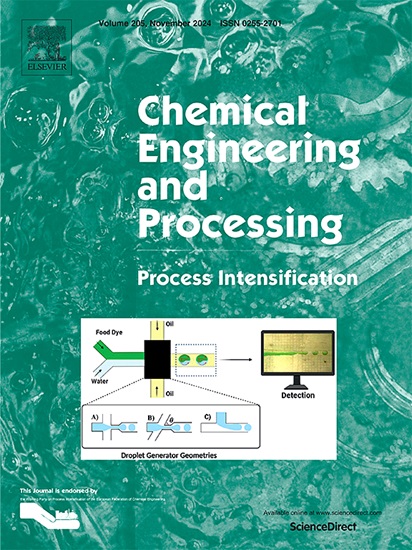多射流水动力空化产生体积微纳气泡水的特性研究
IF 3.8
3区 工程技术
Q3 ENERGY & FUELS
Chemical Engineering and Processing - Process Intensification
Pub Date : 2025-02-06
DOI:10.1016/j.cep.2025.110210
引用次数: 0
摘要
微纳气泡(MNBs)技术为解决水处理问题提供了创新的理论基础和应用前景。然而,制造具有高MNBs发电效率的气泡发生器一直是一个挑战。为了提高气泡的剪切破碎效果,本文设计了一种新型的水动力空化气泡发生器。通过数值模拟研究了不同直径和速度的气泡在射流孔中的破碎行为。同时,建立了文丘里气液混合器内两相流湍流模型,分析了不同进气速率下的内部流场。通过图像分析和溶解氧传感器分别测定了散装MNBs水的气泡大小和溶解氧(DO)浓度。结果表明:空化发生器产生的气泡直径不大于27.85 μm;此外,MNBs发生器具有较好的溶氧能力,是普通曝气水的1.48倍。本研究加深了对气泡破碎机理的理解,为MNBs生成技术的设计和开发提供了参考。本文章由计算机程序翻译,如有差异,请以英文原文为准。

Study on the properties of bulk micro-nanobubbles water generated by multi-jet hydrodynamic cavitation
The micro-nanobubbles (MNBs) technology provides an innovative theoretical basis and application prospect for solving the problem of water treatment. However, the fabrication of bubble generators with high MNBs generation efficiency has always been challenging. Herein, we developed a new hydrodynamic cavitation bubble generator by equipping the multi-jet reactor to enhance the shear breakage effect of bubbles. The breakup behavior of bubbles with different diameters and velocities in jet orifices was investigated by numerical simulation. At the same time, the turbulent model of two-phase flow in the Venturi gas-liquid mixer was established to analyze the internal flow field under different intake rates. The bubble size and dissolved oxygen (DO) concentration of bulk MNBs water were determined through image analysis and a DO sensor, respectively. The results showed that the cavitation generator produced bubbles with diameters no larger than 27.85 μm. Moreover, the MNBs generator exhibited a superior oxygen-dissolving capability, which was 1.48 times that of general aerated water. This study has deepened the comprehension of the bubble breakup mechanism, providing a reference for designing and developing of MNBs generation technology.
求助全文
通过发布文献求助,成功后即可免费获取论文全文。
去求助
来源期刊
CiteScore
7.80
自引率
9.30%
发文量
408
审稿时长
49 days
期刊介绍:
Chemical Engineering and Processing: Process Intensification is intended for practicing researchers in industry and academia, working in the field of Process Engineering and related to the subject of Process Intensification.Articles published in the Journal demonstrate how novel discoveries, developments and theories in the field of Process Engineering and in particular Process Intensification may be used for analysis and design of innovative equipment and processing methods with substantially improved sustainability, efficiency and environmental performance.

 求助内容:
求助内容: 应助结果提醒方式:
应助结果提醒方式:


